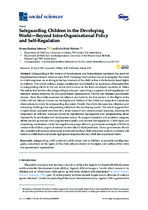| dc.contributor.author | Julia, Sloth-Nielsen | |
| dc.contributor.author | Afrooz Kaviani, Johnson | |
| dc.date.accessioned | 2021-07-23T11:48:39Z | |
| dc.date.available | 2021-07-23T11:48:39Z | |
| dc.date.issued | 2020 | |
| dc.identifier.citation | Afrooz Kaviani Johnson & Julia Sloth-Nielsen, 2020. "Safeguarding Children in the Developing World—Beyond Intra-Organisational Policy and Self-Regulation," Social Sciences, MDPI, Open Access Journal, vol. 9(6), pages 1-19, June. DOI: https://doi.org/10.3390/socsci9060098 | en_US |
| dc.identifier.uri | http://hdl.handle.net/10566/6437 | |
| dc.description.abstract | Safeguarding in the context of development and humanitarian assistance has received heightened international attention since 2018. Emerging literature has not yet investigated the extent to which responses are evolving in the best interests of the child, in line with the treaty-based rights of children. This article makes a unique contribution to scholarship by applying a child rights lens to safeguarding efforts in the aid sector with a focus on the least developed countries in Africa. The article first reviews the safeguarding landscape—providing a snapshot of self-regulatory and standard setting initiatives by non-government organisations (NGOs) and bilateral government donors. Next, the article examines the relevant standards in the Convention on the Rights of the Child and the African Charter on the Rights and Welfare of the Child and respective Committee observations to enrich the safeguarding discussion. Finally, the article discusses key dilemmas and remaining challenges for safeguarding children in the developing world. The article suggests that a rights-based approach provides for a more nuanced and contextualised response, avoiding the temptation of ‘tick-box’ exercises driven by reputational management and ‘programming siloes’ imposed by humanitarian and development actors. To support sustained and consistent progress, efforts should go beyond intra-organisational policy and sectoral self-regulation. Child rights law monitoring mechanisms can be leveraged to encourage effective government oversight of NGOs in contact with children, as part of national frameworks for child protection. Donor governments should also consider and increase investment in national and local child protection systems to address risk factors to child abuse and ensure appropriate responses for any child that experiences harm. | en_US |
| dc.language.iso | en | en_US |
| dc.publisher | MDPI | en_US |
| dc.subject | safeguarding | en_US |
| dc.subject | African charter on the rights and welfare of the child | en_US |
| dc.subject | non-government organisations | en_US |
| dc.subject | child protection | en_US |
| dc.subject | child abuse | en_US |
| dc.subject | risk to children | en_US |
| dc.title | Safeguarding Children in the Developing World—Beyond Intra-Organisational Policy and Self-Regulation | en_US |
| dc.type | Article | en_US |

